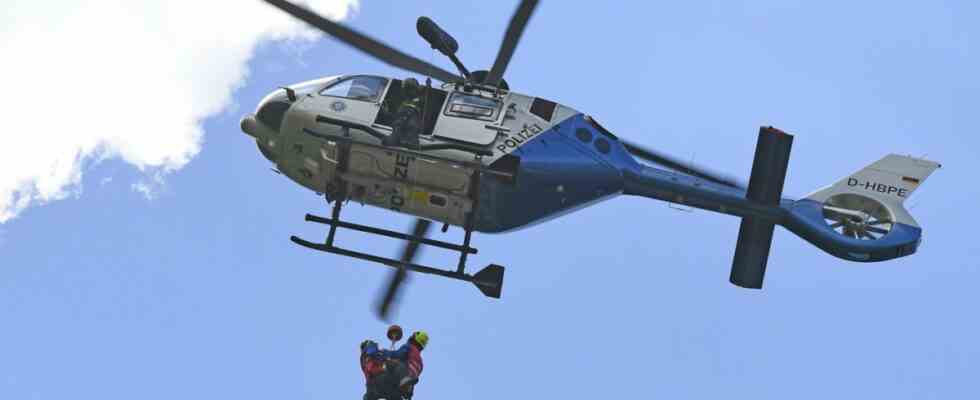It was only a few days ago that an 81-year-old woman fell 30 meters down a mountainside during a mountain hike towards the Gedererwand near Aschau in the Chiemgau. When the emergency doctor and the people from the mountain rescue service arrive, she is still alive, but in the end they can no longer save the woman. Or recently over on the Untersberg. An experienced mountaineer, traveling alone, slips and falls 40 meters. For him, too, any help comes too late.
Such accidents happen again and again in Bavaria’s mountains, and their number increases with the number of people drawn to the mountains. And more and more accidents are fatal. From January to June of this year alone, 30 people lost their lives in the mountains in the area of the police headquarters in Upper Bavaria South, which stretches from Berchtesgaden to Garmisch-Partenkirchen. In the whole of 2021, there have been 55 mountain deaths in the area – more than at any time since 2009, when police began to systematically record the number. The triggers for this – a simple slip, a short stumble – are mostly banal. The reasons behind this are manifold.
For Beppo Maltan, it often starts with the language. Maltan is chairman of the DAV section Berchtesgaden and is also involved in the Alpine Club at national level. “Hiking,” says Maltan, for example, going from the train station in Berchtesgaden to Königssee. Being out and about in the Steinernes Meer is no longer hiking, “that’s mountaineering”. If that were already clear, then the “alpine information” of the Berchtesgaden Alpine Association would perhaps not receive as many inquiries as that of a group leader who went from St. Bartholomä to the Ingolstadt house with his 17 hikers and wanted to know beforehand whether the shortest route does not lead over the Watzmann east face.
No legal vacuum
Careful planning is one of the rules for a safe mountain experience, which DAV man Maltan lists. He cites stumbling, slipping, exhaustion and disorientation as the most common causes and occasions for accidents and rescue operations. According to Maltan, those who set off with the most honest self-assessment run the lowest risk of having a serious or even fatal accident.
If something does happen, people like Nik Burger are in demand. Burger is the professional director of the district court in Laufen and also the head of the mountain rescue service in the Chiemgau region and a trainer for mountain rescue services. Burger, who himself hangs on a rope under a helicopter to get casualties out of walls, can describe and analyze a rescue mission in the mountains in detail. On Tuesday he did this on the Jenner above the Königssee for Bavaria’s Interior Minister Joachim Herrmann and Justice Minister Georg Eisenreich, among others. The ministers were guests of the Bavarian Board of Trustees for Alpine Safety, an association of numerous institutions and associations involved in the mountains.
The Minister of the Interior and the Minister of Justice are also the top managers of those people who often come right after the mountain rescue service: the approximately 80 specially trained and mountain-experienced officers of the Bavarian police’s Alpine Task Force, for example, who have to clarify the circumstances of a mountain accident – especially one thing deadly, which then regularly calls specialized public prosecutors such as the head of the public prosecutor’s office in Traunstein, Wolfgang Beckstein, to the scene. To be on the safe side, the mountains cannot and should not be provided with warning signs everywhere or blocked completely, says Beckstein, but they are not a legal vacuum either. If someone has a fatal accident in the mountains or a corpse is found – according to Beckstein “usually not a pretty sight” – then the public prosecutor’s office must investigate. For example, because of negligent homicide, if someone has badly secured someone else or someone above the casualty caused a rock fall through carelessness.
From the prosecutor’s point of view, however, most fatal accidents have very trivial causes. Beckstein estimates that maybe two or three of the 55 fatal mountain accidents in southern Upper Bavaria last year had criminal consequences. It becomes more difficult from a legal point of view in the case of skiing accidents, when it comes to who is to blame for a collision on the piste.
Mountain bikers remain inconspicuous
According to the German Mountain Bike Initiative, summer mountain cyclists are not disproportionately represented in the accident statistics. In 94 percent of the relevant accidents, the bikers fall alone, and mostly in special bike parks than in the great outdoors, only eleven percent of the accident cyclists were on e-bikes. Collisions with hikers have not been registered at all in the past 20 years.
On the other hand, the number of deaths in the mountains is significant, even compared to other types of death. In Berchtesgadener Land alone, according to Minister of Justice Eisenreich, twelve people died in the mountains last year – and a total of eight in road traffic. Some time ago, the Board of Trustees for Alpine Safety promoted the introduction of a cross-border mountain emergency call app for mobile phones in Bavaria, Tyrol and South Tyrol. As chairman of the board of trustees, Klaus Stöttner (CSU), a member of the Rosenheim state parliament, announced that the “SOS-EU-Alp” app would be expanded by the end of the month with a tracking function that would record the user’s route and show the rescuers the way at least to the last location with cell phone reception.

